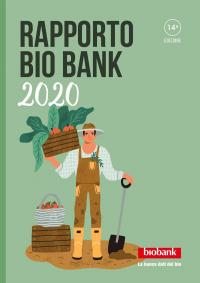
The Bio Bank 2020 Report, now at its 14th edition, focuses on six new types of activity, with a set of data even richer. The scenery of organic in Italy and new elaborations on the market are now added. The most authoritative sources of organic data are then complemented by key references to sustainability. All in 74 pages freely available at this LINK.
The new Report analyses the Italian organic market development from 2011 to 2020. In 2020, the total organic market in Italy reached 6.9 billion euros (Nomisma data for Osservatorio Sana). The internal market, amounting to 4.3 billion euros, has more than doubled in ten years (+118%). But it was above all large-scale distribution that generated and intercepted the market growth, with sales of over 2 billion euros (+279%). All other distribution channels, with sales of 2.3 billion euros, grew by 58%. And the export has reached 2,6 billion euros (+131%). Organic farms also grew, more than 80 thousand in 2019 (+34.5% in 10 years), as well as organic areas, almost 2 million hectares (+33.5% in 10 years), equal to 15.8% of the agricultural surface cultivated in Italy (Sinab data).
The Report then analyses the trend of activities between 2015 and 2019 for three categories, photographing 3,476 "organic activities" surveyed by Bio Bank in 2019. The first place is occupied, as in the past, by the organic food e-commerce sites, which reached 405 (+41.6%): an already positive trend now accelerated by the pandemic. At the second place the organic restaurants, 543 (+20.7%), a position that for sure has dramatically changed in 2020 due to forced lockdown. Organic shops (-4%) decresed to 1,339, suffering competition from large retailers, anyhow reacting by focusing on aggregation. The propulsive phase of organic cosmetics continues: activities have grown by 121.4%.
The Report finally analyses which were, in 2019, the leading regions for organic activities, confirming once again in the first two places of the ranking Lombardy and Emilia-Romagna, with an entry of Veneto in the third place. These three regions concentrate 1,379 activities on the total of 3,476, actually four out of ten. The Marches remain at the head of the ranking by density (number of activities per million inhabitants), while the Trentino-Alto Adige comes in second place, followed by Emilia-Romagna. The Report also presents the regions excelling in every type of activity, by absolute number and density. A fresco of the Italian organic, between entrepreneurial skills and territories’ vocations.
Source: Bio Bank



